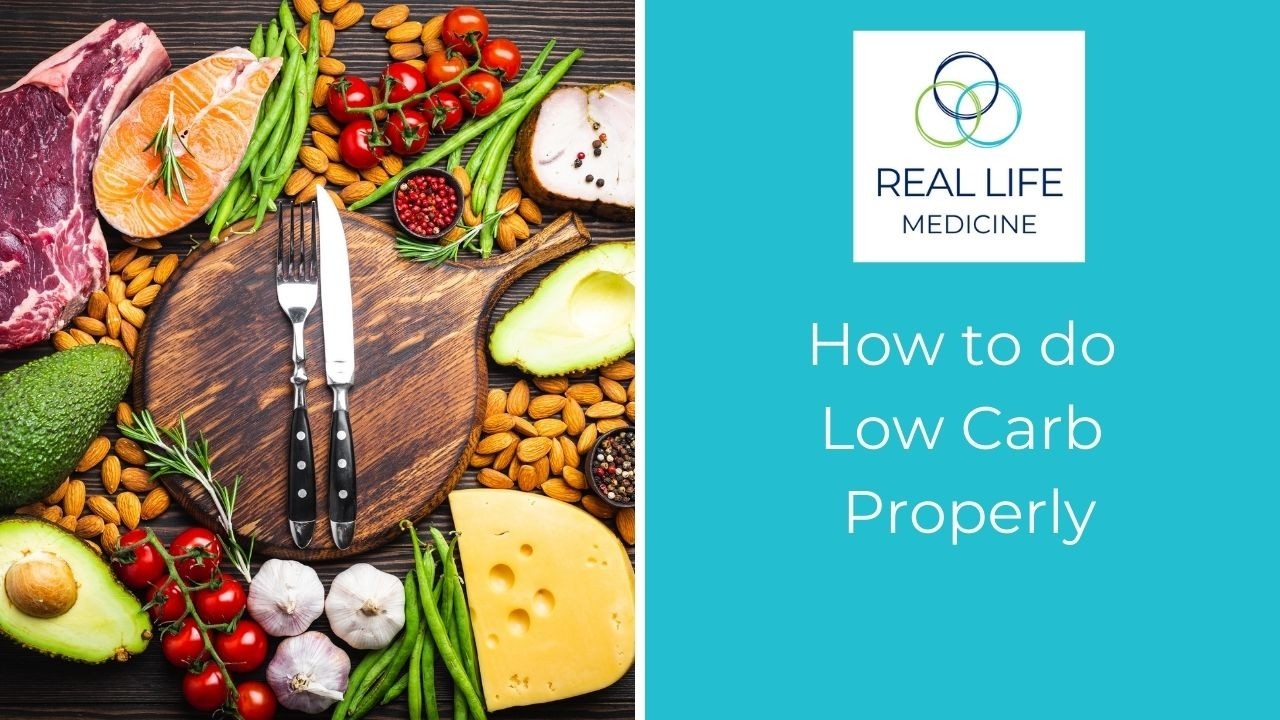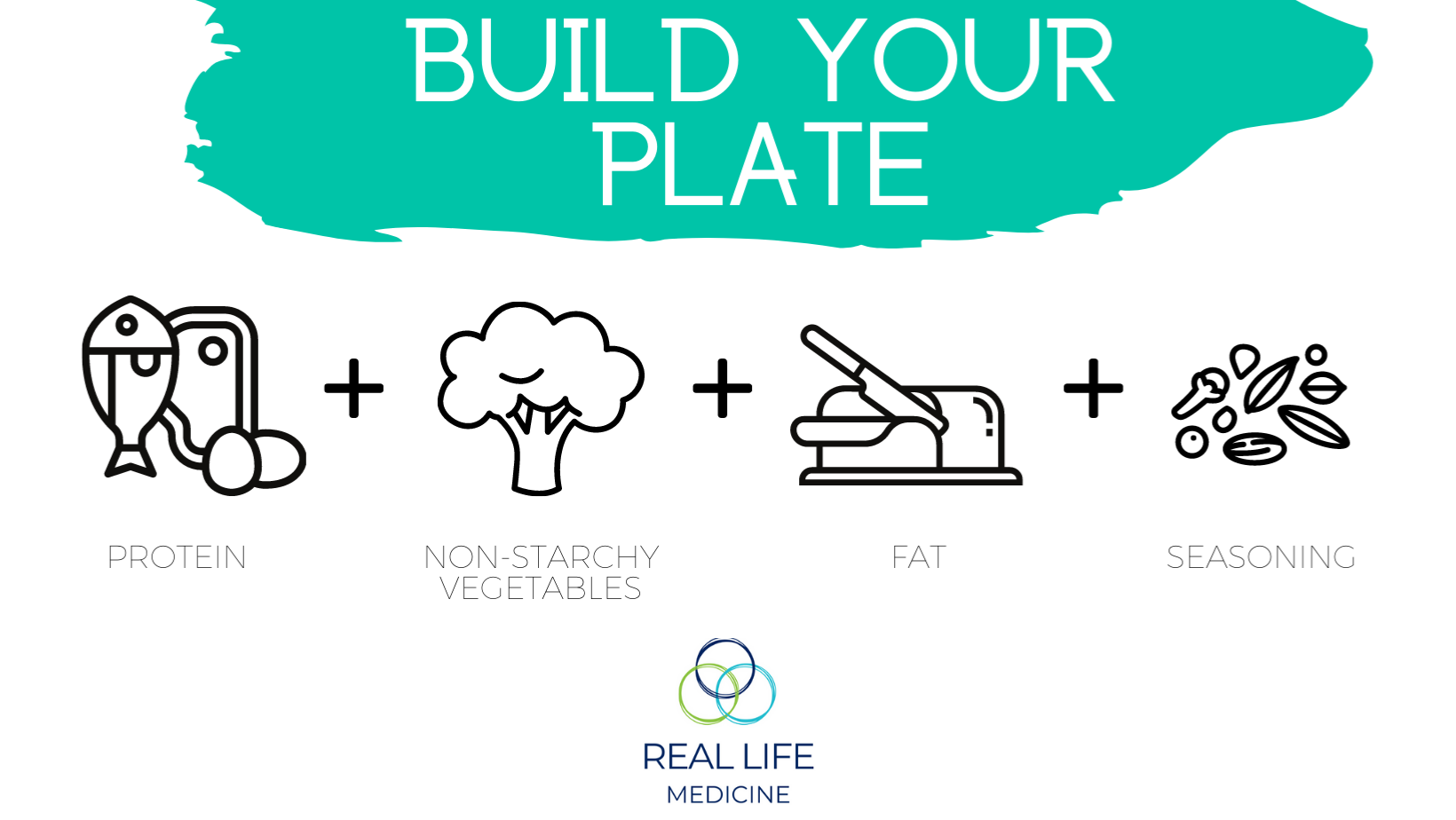
How to do low carb properly
Oct 07, 2021Even in low carb world, there is no shortage of dietary options out there. Ketogenic diet, lazy keto, clean keto, dirty keto, low carb, low carb high fat, zero carb, Atkins, modified-Akins, eco-Atkins, carb-cycling, South Beach…. the list goes on.
Knowing what diet is best can be confusing.
Although it seems really complicated, we (Dr Mary and Dr Lucy) like to keep it really simple.
This is our simple dietary philosophy in two steps:
Step one = Eat Real Food
Eat nutrient-dense real food based on whole foods from nature. The Real Food diet emphasises whole foods that are rich in nutrients, while avoiding processed, inflammatory and refined foods (like refined sugars and grains) that drive chronic disease.
Real Food is food eaten as close as possible to its natural state, when it was taken from the animal or the plant, with minimal processing. Real food is vegetables, fruit, nuts, seeds, fish, seafood, eggs and meat.
Simply eating real food and cutting out damaging processed and inflammatory refined foods, will make a huge difference to everyone’s health. For some people though, if they want to lose weight and heal their metabolic health, they need to take it a step further.
Step two = Eat Low Carb Versions of Real Food
If you have a weight loss goal, if you are overweight or obese, have fatty liver, type two diabetes, pre-diabetes, insulin resistance or high circulating insulin, then eating low carb versions of real food will allow your metabolism to heal, and allow you to lose weight sustainably.
Low Carb Real Food is real food that is naturally lower in carbohydrates. A low carb real food diet includes low-carb veggies (more of the gorgeous vegetables that grow above ground, and much less of the veggies that grow below ground), some low carb fruit (berries are pretty low carb, most other fruit is high in carbs and best avoided), nuts, seeds, fish, seafood, eggs and meat.
We LOVE low carb real food at Real Life Medicine. Along with compassionate mindset management, low carb Real Food (LCRF) is the cornerstone of our health philosophy.
To count or not to count
Here’s a little secret, to eat LCRF you don’t need to count your carbs, fats or proteins (unless you want to). You certainly don’t need to count calories. No maths is needed at all.
At Real Life Medicine, we are firm believers that you DO NOT need to track macros to benefit from a low carb real food lifestyle.
“Macros” = the macronutrients that make up the food in our diet, they are carbohydrates, protein and fat. It is important to ensure that you get all the protein and fat you need (there is no minimum requirement of carbohydrates that the body needs). But you don’t need to count them.
You can simply eat foods from The Green Food List. And follow the simple ‘’Build Your Low Carb Real Food Plate’’ guidelines (below). By following these simple steps, your macros will be roughly right without needing to do any arithmetic whatsoever. And when it comes to food, roughly right is fine. Our bodies are very clever, we can make our own proteins, fats and carbohydrates within our bodies. They don’t need perfect nutrition calculated right down to the nearest milligram. But we do need a good sensible amount of fuel and building blocks in our food. Guess what makes the best building blocks for good health and sustainable weight loss? Low Carb Real Food. Give our bodies low carb real food, and they will fire out the rest. Human biology is beautiful!
And with our green list, you can make some delicious Low Carb Real Food meals! Like this creamy chicken surprise, this Moroccan beef, or this deliciously simple Mexican baked eggs.
How to Build Your Low Carb Real Food Plate (without counting macros)
- Pick a protein - protein is the foundation of the plate. For example, chicken, fish, seafood, beef, lamb, pork, vegetarian options (tofu or tempeh).
- Cook it in some fat. For example, coconut oil, olive oil, macadamia oil, butter, lard, duck fat (obviously skip this bit if the protein is already cooked).
- Add in veggies or salad.
- Add some extra fat to the meal (note that if the meat cut is fatty, you can skip this bit). For example, add butter to the veggies, drizzle olive oil on your salad, add a piece of cheese, a handful of nuts or a slice of avocado.
- Optional salt and seasoning - added at any stage of the preparation.
Here is that equation again: Protein + Fat + Veggies + Salt & Seasoning = Done!

A Low Carb Real Food lifestyle has incredible power to heal the metabolism and facilitate sustainable weight loss. But how low is ‘low’ when it comes to low carb?
Well, it depends.
How low you go depends on your metabolism, your goals and your own preferences.
You are the boss of you. You get to decide how low you want your carbs to be.
Pregnant women, breastfeeding women, and children should not go too low with their carbs. Also, people taking certain medications including SGLT2 inhibitors (common medications used in type 2 diabetes), people on other diabetes medication or blood pressure medication, and people with chronic disease should get medical supervision before changing their diet.
The simple recommendations we have are:
- If you are using your Low Carb Real Food diet as a complementary therapy, to treat an established medical condition like type 2 diabetes, fatty liver, seizures, cancer, etc. - then a strict ketogenic diet of less than 20g carbohydrates a day might be best.
- If you are using your Low Carb Real Food diet to generally improve health and wellness and to lose weight, then a more liberal low-carb diet of somewhere between 40-80g carbohydrates might work best for you. More on this below.
What is the difference between Keto and Low Carb?
Ketogenic or Keto Diet = a diet very low in carbohydrates (typically less than 20g/day) that induces nutritional ketosis.
We don’t specifically advocate ketogenic diets, but we are not against them.
Nutritional ketosis (quite the mouthful!) describes a state where your body is using fat (rather than glucose or sugar) as its primary fuel course. Our liver is always pumping out ketones to a degree. When you restrict your carbohydrate intake for one or two days, then the liver ramps up its ketone production, and your body uses ketones as an alternate source of fuel (instead of glucose). Once the ketones in the blood reach a certain threshold (generally considered to be >0.4 mmol/L of beta-hydroxy-buterate - the ketone measured in the blood) you are said to be in “nutritional ketosis”.
So, being in nutritional ketosis means your body is burning fat for fuel.
Ketones are a perfectly natural fuel source. They have a number of health benefits including improved mental clarity.
It is not essential to be in nutritional ketosis to reap the benefits of a low carb diet. Being in nutritional ketosis does not mean you are losing weight, all it means is that your body is burning fat for fuel. You could be burning the fat that you eat, or the fat you have stored in your body. Also, you can lose weight on a low carb diet without being in nutritional ketosis.
What is a Low Carb diet?
Low Carb Diet = a diet low in carbohydrates that may or may not induce ketosis. There is no set definition of what a low carb diet actually is. Some people consider anything less than 150g carbohydrates a day as low carb, others 100g, whilst others define it as less than 50g a day. Generally less than 80g a day is our version of low carb, less than 40g is generally what we recommend if weight loss and metabolic health is your goal.
Remember, you can still lose weight doing a low carb diet that does not induce nutritional ketosis, but if you are very insulin resistant then we would suggest keeping your carbs as low as possible.
Macro Guidelines
The following Macro Guides are only guides. There is no need to be rigid, but by the same token, you don’t want to be too “flexible” or you won’t lose any weight!
Ketogenic Diet Macros
To get into nutritional ketosis most people will need the following macros:
- Carbohydrates - <20g net carbs (total carbs minus fibre).
- Protein - aim for 1-1.5g/kg of ideal body weight. For most people this is around 60-90g protein a day.
- Fat - range from 100-200g a day. When you first start a ketogenic diet, you may need more fat initially until your body gets fat adapted, your insulin goes down and your “woodshed” opens.
Low Carb Diet Macros:
- Carbohydrates - as low as you can comfortably go, less than 40g carbs will likely facilitate healthy weight loss. Anything less than 80g is still low carb from our point of view.
- Protein - aim for 1-1.5g/kg of ideal body weight. For most people this is around 60-90g protein a day.
- Fat - range from 100-200g a day. When you first start a ketogenic diet, you may need more fat initially until your body gets fat adapted, your insulin goes down and your “woodshed” opens.
Tracking Apps
Tracking apps are the most practical way to count your macros. Just remember to set them using net carbs. None of the tracking apps are perfect, after trying a few we prefer to use the Carb Manager App.
So, in summary, the quality of your food is by far the most important factor when creating your healthy lifestyle. Crappy processed keto chocolate bars, protein shakes, powdered MCT oil and keto candy, might meet the “keto macros”, but they are full of processed and inflammatory nasties that will do you no good at all. Focussing on healthy natural foods, the kinds of natural foods we evolved to eat, will nourish your body back into health. It will nourish your metabolic hormones back into balance for sustainable weight loss and life long health.
Low Carb Real Food.
It is really simple.

